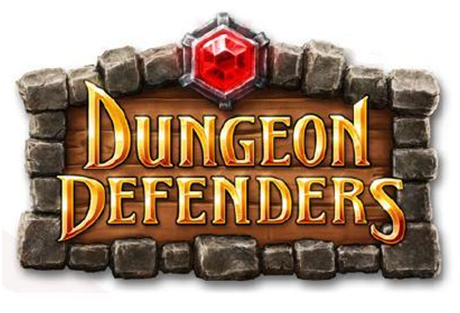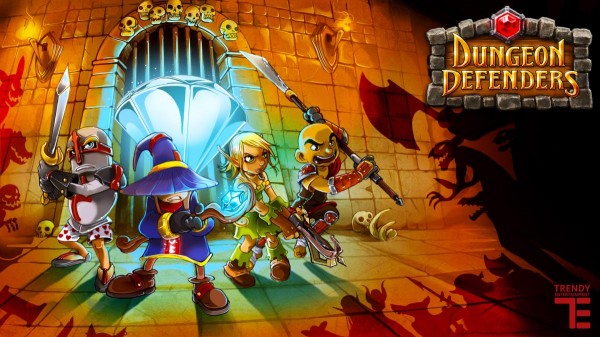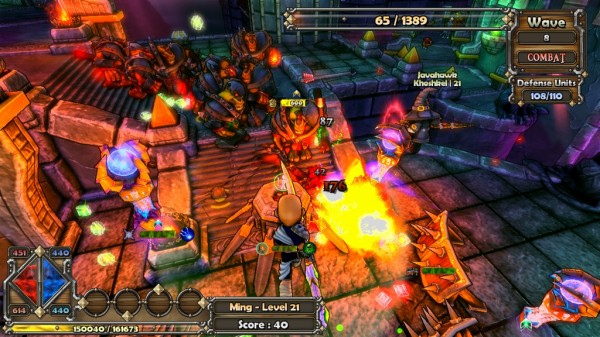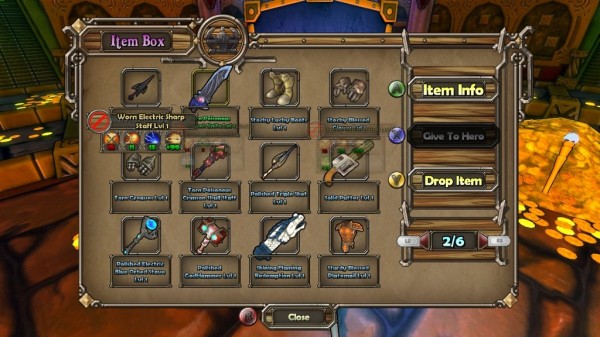Dungeon Defenders review (XBLA)
Dungeon Defenders was developed by Trendy Entertainment and published by Reverb Publishing. It was released on October 19, 2011 for 1200 MSP. A copy of the game was provided for review purposes.
Loot, levels, and fantasy creatures–the essence of most RPGs. Add hack and slash, also quite the staple, and spells, then four different classes, then add an array of towers to summon, four player coop, challenge levels, survival and tower-only modes, a player versus player mode, and plenty of customization. In a nutshell, or perhaps an empty watermelon? No, maybe a carved out star. Yeah. That’s Dungeon Defenders. This action RPG tower defense has an abundance of content, variety, and polish; what do you know, the three spices of life!
Dungeon Defenders takes a semi-new approach to the tower defense genre, employing traditional elements like loot, leveling up, classes and towers while also changing the mentality up, advocating use of blockades at choke points and giving each class a different set of towers to summon as well as abilities. Of the four classes are the Apprentice, magic user employing high damage dealing elemental towers; the Squire, who takes the hordes with a sword while being backed by meaty blockades; the Huntress, with ranged weapon in hand and powerful multi-use traps; and lastly the Monk, support class extraordinaire, able to use both ranged and melee attacks and summon auras which apply affects or damage over a wide area. Levels are long and allow for up to four players with drop in and out coop local or online. Each level also has a challenge mission which presents distinct gameplay variations that force players to change their tactics, foregoing entire elements of the game or sometimes making them more important. The loot system is robust, allowing for set bonuses, rewarding players for playing on higher difficulty levels and with more people in their party. Mana gained during levels can be used to upgrade weapons, armor and pets.
There’s just so much in this game, it’s mind boggling.
Here’s what we liked:
Cooptimized – Here are some of the ways in which the gaming public can enjoy Dungeon Defenders: play by themselves with one character, or using the abilities of multiple characters to bring all the towers into the level; play with a friend (or mortal enemy) on the couch next to them; play with that same friend or rival over the internet; play with someone on the couch, and someone on the internet. Every permutation of coop is possible, and to top it all off the game scales on the fly with drop-in and drop-out, allowing players to play for as long as possible and not punish their mates if they have to leave in the middle of a level. On top of that, guests can take the host player’s character’s online to help level them up when playing over Xbox Live. The splitscreen doesn’t have any slowdown, challenges and even the regular levels are more fun and rewarding with more people, there’s really no reason to play this game solo.
Stuff! Stuff everywhere – LOOT! Dungeon Defenders is spilling over itself with loot. Stuff to wear, stuff to kill things with, stuff to follow you around and make funny noises (while killing things), just stuff everywhere! Every level will give more and more loot as the level goes on, give better loot on higher difficulties (so even earlier levels can give worthwhile loot if they’re returned to), and every bit of loot has tons and tons of stats to look at and fawn over. If all those numbers are too much to read, a simple “thumbs up/down” system is employed to make finding out whether or not an item is an upgrade easy. For those who want to go in-depth on the stats, there’s a comparison in every piece of the game, so it’s easy to see what players want and don’t want. Randomization knows no bounds here, even the boss loot (which is the same weapon every time) has randomized stats (to a degree) and can even change in size, so playing a boss multiple times can always be rewarding.
Better each time – The first play through of Dungeon Defenders is a tough one, filled with harsh lessons and probably failure depending on how familiar players are with the genre. The second play through is supremely rewarding, filled with better loot, and a new-found understanding of the game. Then, after that is the new character, seeing the game from a whole new perspective. Beyond that is the challenge run, taking the best characters into the challenges at a medium difficulty. Then there’s insane, with the most intense challenge, best loot, and highest risk/reward. While it didn’t take long to read, we guarantee it’ll be a long time to achieve. There’s plenty to do in this game and plenty of reason to go back and play levels over and over.
No cake walk – Dungeon Defenders challenges players to be strategic, or to have characters that are so incredibly awesome that strategy might be foregone (and even then it will punish them if at all possible). Challenges are difficult in concept, and far more difficult in practice, often scaling up steeply halfway through the level. The regular levels are pretty doable the first time through on medium, definitely on easy, but by the time players hit insane the whole game demands perfection. Some games rely on pure skill when it comes to harder difficulties, but not Dungeon Defenders, there’s a certain demand for time, devotion, and understanding of the game’s mechanics that must be achieved before the best fruits of Dungeon Defenders might be tasted, delicious and juicy as they are.
Early game AND end game – There’s nothing more frustrating about an RPG that blows its load in the first couple hours or saves it for the end of the game; Dungeon Defenders does neither. It’s like being at the end of the conveyor belt in a cake factory, with each cake getting bigger, more complex in taste, and of course more delicious (and probably less nutritious). The early game is one of learning and adventure, which for RPG fans is an absolute win because there’s plenty of early returns, new loot and new towers and abilities up until level 20. From there, much is to be learned about each character, the ins and outs of the many builds that are possible, how to work with other classes, and where to best implement certain strategies. Midway, challenges can be attempted to see the game in a different light. End game has insane mode, which really demands a lot from players, and godly tier armor, weapons and pets give players something to go for. Unlike other RPGs, the “godly” modifier isn’t reserved for boss loot, so some of the best loot of the game will be crafted by players through upgrades and be entirely randomized, allowing for end-game variety instead of every level 70 having the same gear.
Like this? Like that? – Each of the thirteen levels demands different strategies, save for maybe the first two or three (at least on medium). Playing solo means an incredibly different strategy from playing with four players, where the game scales up in difficulty both in the stats of enemies and more noticeably their numbers. Used to playing a Squire? Try the Monk! Perhaps a buddy is a Monk, but he’s not on, now the pick up group doesn’t even have a Monk, how will the strategy change? Rest assured every game can be different depending on the builds of each player and which character was brought to the game.
Polish – Clearly a lot of love went into this game. Rather than sitting on their hands during the year that Dungeon Defenders was pushed back, Trendy Ent got to work putting more and more into the game, allegedly adding several weapon models, more customization options, and optimizing performance. This game is graphically astounding, especially for the price, and doesn’t slow down despite massive amounts of enemies on screen most of the time. On top of that, many decisions have been made to streamline processes and ensure that players have a series of smart backup running through the engine, instead of having to rely on themselves.
Here’s what we didn’t like:
Super nitpicking and user interface – The only real issues that stand out with this game are a pretty intense cluttering of the screen in the item box, minimap, or even on the level itself depending on what the player is doing at the time. There’s a billion numbers to look at and tiny icons, so playing splitscreen can be a nightmare when it comes to looking at stats. It’d be nice as well if there were more customization available for the PVP bits of the game. Perhaps it could use more levels? Really we’re grasping at straws here, but a busy UI is all that stands out as a negative issue.
For action-RPG and tower defense fans alike, Dungeon Defenders is not just like being a kid in a candy store, but a kid in a candy store who never knew what a candy store was, and giving him a $100 gift card. This game is filled to the brim with content, all of which can be tackled coop, played over and over and in many different ways each time. The Xbox Live Arcade marketplace maybe didn’t need yet another tower defense game, but if it ever needed one, it needed Dungeon Defenders. There’s tons to do, and it’s all deep and takes advantage of the awesome stats, leveling and loot system. There are a million little bits and pieces that were polished where they could have easily been forgotten, for instance mana and items left on the field after each wave are sold and divvied up evenly to the players rather than disappearing forever or sitting there, the level that takes place in the rain actually has water flowing down the architecture and statues, it’s just an amazing looking, feeling, and playing game.
Score: Buy It!!!





